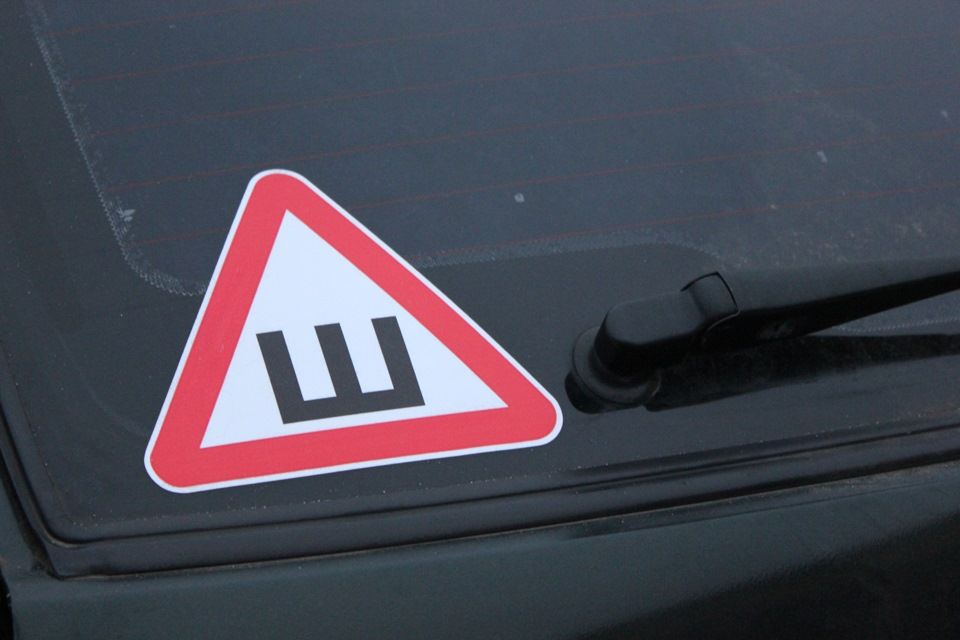The driver must know where the "Spikes" sign is installed, what it means, what it is for. The number of accidents increases with the onset of the winter season, the road becomes slippery, the braking distance of the car increases, so there is a need to replace rubber. Does the law provide for penalties for the absence of the sign "Spikes"? How to stick a sign so as to provide maximum visibility? We will try to answer these questions in our article.
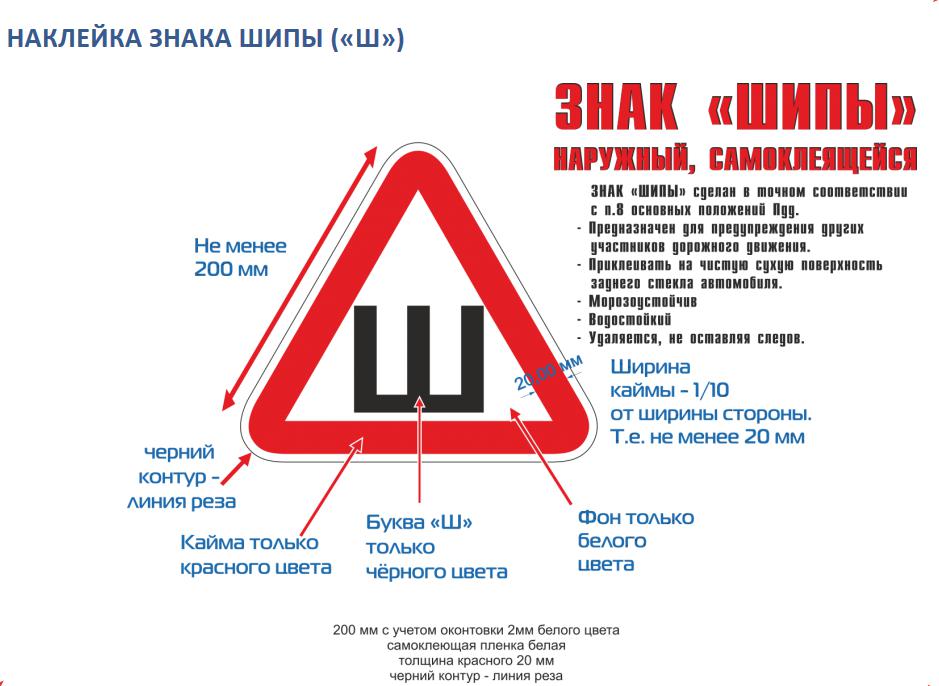
The meaning of the sign "Spikes"
Types of rubber for the cold season:
- Studded.
- Combined.
- With grooved protectors.
SDA provides the installation of the sign "Spikes" only on a vehicle with studded tires.
Not all road users understand what the Thorns sign is for. Consider why penalties are provided for his absence.
Reasons for installing the sign on a vehicle:
- Informing motorists who drive behind that it is necessary to pay attention to reducing the stopping distance of a car equipped with studded tires.
- If the rubber is of poor quality, then the spikes can fly out, so a safe distance must be observed.
The absence of the "Spikes" sign in the presence of studded tires can be a weighty argument in determining the culprit of a traffic accident. This situation may occur if, during emergency braking, a vehicle in the rear bumps into the bumper. In this case, the court can convict both drivers.
Where to install the sign on the car
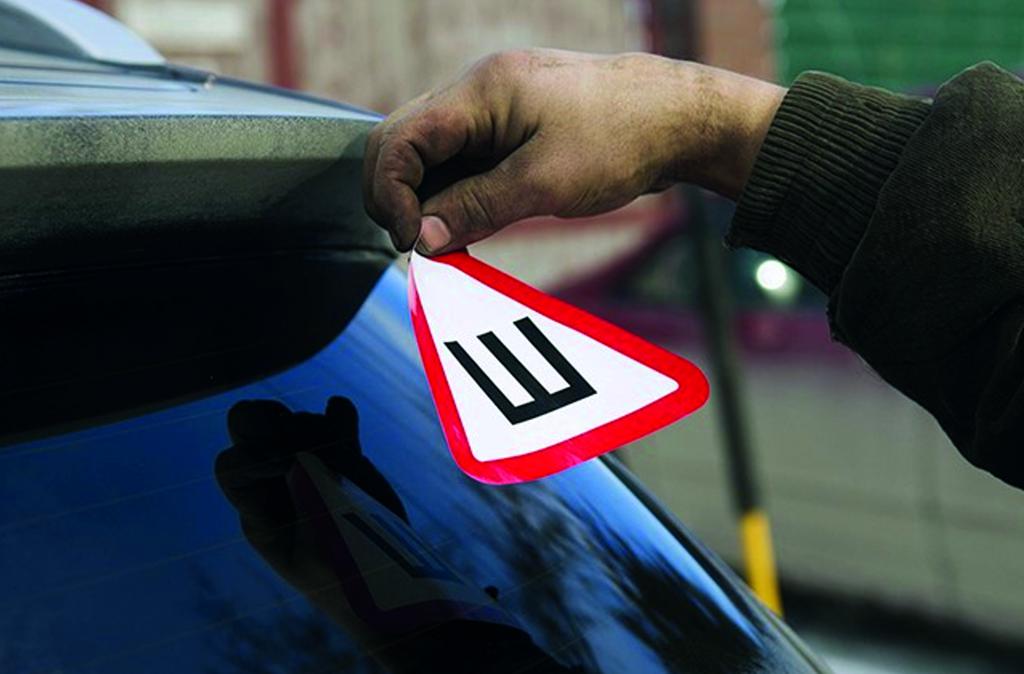
Many drivers have a question, where is the sign "Spikes" installed on the glass. How to do it right according to traffic regulations? Carefully reading the main provisions of the rules, you can find only an indication that the sign "Spikes" should be placed behind the vehicle. Other regulatory documents also lack more precise guidance. Therefore, it is permissible to stick the "Spikes" sign on the car in different places.
Where is the "Spikes" sign installed on the car:
- On the rear window, from the inside or outside.
- On the trunk lid.
- On the bumper.
- On the back of the body.
Thus, you just need to choose the place where the sign is placed. You also need to make sure that it is clearly visible.
Options for placing the sign "Spikes"
Many drivers have a question, where on the car the sign "Spikes" is installed to provide visibility for drivers of vehicles located behind. It is important to observe two conditions:
- The sign shall not interfere with the driver of the car with studded tires.
- It should provide a warning function for road users.
If you ask the question where the "Spikes" sign is installed on a passenger car to a driving instructor, you will receive the necessary information. Most often it is recommended to place such signs on the rear window in the left or right corner.
Now there are a large number of cars with different bodies. Where, according to the rules, the "Spikes" sign is installed on passenger vehicles to provide better visibility at any time of the day? Motorists believe that the best place for sedans is the top of the rear window. The fact is that in the presence of a long trunk, the light will be deflected from the paintwork. As a result, the sign can simply not be seen.
Where is the "Spikes" sign on the rear window installed if it is equipped with heating threads? In this case, the driver must take into account that the sign will have to be removed after the winter season, and the sticker may damage the threads. To avoid this, stick the sign on the outside.
In addition, you can stick it near the taillights without closing the license plates.
The owner of the vehicle should think in advance that the sign will have to be removed and glued again. Stickers can be used only once, removing them is also not very simple, since traces of glue are poorly removed. There are other options for attaching the sign, for example, using suction cups. If you place three suckers at the corners of the sign, then it will hold well, it can be used several times.
Sticker sizes
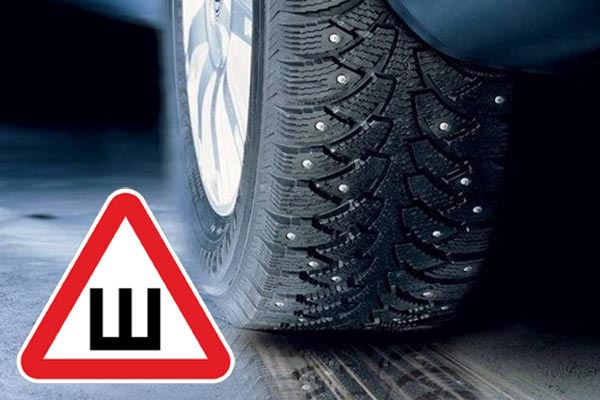
Vehicle owners are interested not only in the place where the "Spikes" sign is installed on the car, but also in its size. They are not regulated by GOST. According to the rules of the road, the sign must be in the shape of a triangle, with sides of the same length. The sign itself is white, has a red border, and the letter "W" is black. Be sure to place a triangle on the car with the top up. At the same time, an important requirement is that the sticker should be placed only behind the vehicle.
What size should the spikes sign be? In the SDA, this paragraph is not regulated, but there are requirements that must be observed:
- The sign must not interfere with the operation of the wiper.
- Should not close the car number.
The dimensions of the Thorns sign are not important, the main thing is that it be visible to other participants in the movement. It should be visible in the dark at a distance of at least 20 meters.
Car with tinted glass.

Owners of cars with tinted glass have questions with the placement of the sticker. Where is the "Spikes" sign installed on a car with a tinted rear window? By law, there is no ban on placing this sticker on the rear tinted glass. In addition, there are no special requirements where to glue - outside or inside. In this case, it will not work to punish the owner of the car, in which the sign is not clearly visible due to tinted glass.
It must be remembered that the sign "Spikes" is necessary, first of all, to inform other traffic participants and prevent the creation of an emergency. Therefore, it is best to stick the sign on the outside so that it can be seen even in the dark from a distance of at least 20 meters.
Penalties for the absence of the sign "Spikes"
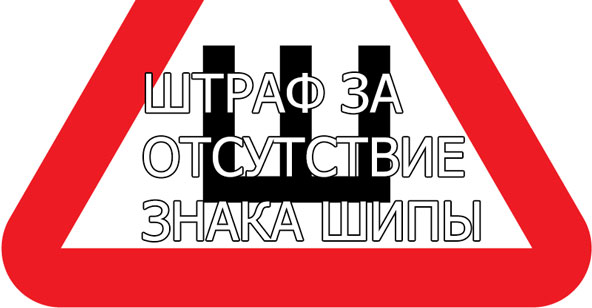
In 2017, small changes were made to the Code of Administrative Offenses. Until that moment, the driver could challenge the punishment imposed, citing the fact that the absence of such a sign is not considered a malfunction. To date, the absence of the sticker "Spikes" is recognized as a malfunction that prohibits the movement of the vehicle.
Traffic regulations require the mandatory installation of the sign "Spikes" behind the car. If the sticker is missing, the driver will be punished under article 12.5 of part 1 of the Code of Administrative Offenses.
The law provides for the following penalties:
- A warning.
- Fine 500 rub.
The sign must be placed in such a way that it is clearly visible to other participants in the movement.
Sticker "Spikes" in the summer
Usually, when weather conditions change, drivers change tires, putting one that is more appropriate for the season. Sometimes car owners forget to remove the "Spikes" sign. Is it possible to ride with such a sticker in the summer? Why is this dangerous?
When you need to “change shoes” a car:
- Winter tires should be from December to March.
- Summer tires - from June to August.
In this situation, the rule works: removed the rubber with spikes - remove the sign, "change the shoes" for the winter - put a sticker on the car. This must be done to ensure safety and prevent emergencies. Other participants in the movement should understand what rubber you are moving on, what is the braking distance of your vehicle.
How could this be dangerous? Consider an example: a car has studded tires, there is no “Spikes” sign. During emergency braking, the car stopped faster. A collision has occurred.A controversial situation arises, as a result of which the guilt is recognized as mutual, because the second participant in the movement did not have complete information and incorrectly calculated the safe distance.
There are no penalties for driving with the “Spikes” sign in the summer. But this can lead to an emergency, therefore it is better to remove the sticker at the same time as replacing the rubber.
Sign "Spikes" during the inspection

Before passing the inspection, the drivers are wondering where the "Spikes" sign should be installed in order to pass the technical inspection without obstacles? Owners of cars with studs on rubber should know that in 2019, during a technical inspection, they will not check for the presence of the corresponding sign. It is not included in the list of requirements that are checked during the inspection of technical equipment.
Rubber "Velcro" - do you need a sign

Rubber manufacturers for automobiles offer different tire options with good grip for less slip. An excellent exit - rubber "flypaper". For drivers who have cars with such rubber, the question arises: do I need a sign "Spikes" for such a vehicle?
The question is logical, because the "Velcro" on the wheels of the car significantly reduces slipping, which leads to a reduction in stopping distance in an extreme situation. There are test data according to which in the winter, a car with Velcro rubber has less braking distance than with spikes. At present, the legislation does not provide for gluing the “Spikes” sign on cars with Velcro rubber.
Pros and Cons of Studded Rubber
With the onset of the cold season, motorists change tires. A logical question immediately arises: where, according to the rules of the SDA, is the “Spikes” sign set? Do people think to get them studded tires or choose other types of tires?
Motorists who prefer studded tires consider it reliable and safe. That it allows you to quickly overcome long distances on an icy road.
Advantages of rubber with studs:
- It gives good grip on icy areas.
- Allows acceleration faster.
- Reduces stopping distance by 50%.
The disadvantages of rubber with studs:
- It is better to use it on a road covered with ice. In other areas, grip is much worse.
- Spoils the asphalt surface.
- Wears out quickly on clean asphalt.
- High price.
- Reduced safety on clean asphalt.
- Unpleasant noise, rattle when driving on asphalt.
Experts recommend paying attention to some features of studded rubber, which are associated with its main purpose. It is most suitable for regions with cold winters and frequent thaws. At this time of the year, ice forms on the road. At the same time, the spikes are not suitable for city streets with dry and clean asphalt.
In addition, you need to remember that studded tires increase fuel consumption. At very low temperatures, it is better not to use such rubber, as it wears out faster and does not fulfill its functions. As a result, the driver has to purchase two sets of winter tires. One without studs for driving on clean asphalt and at very low temperatures. The second is for traveling on an icy road. Therefore, winter tires need to be selected, depending on weather conditions and the condition of the road surface. If the machine is operated in an urban environment, it is recommended that rubber with studs be discarded.
The attitude towards her is ambiguous. In Finland, for example, in winter, drivers are required to drive only studded tires. Russian drivers can choose different tires for vehicles. If necessary, you need to know where the "Spikes" sign is installed. Also, the driver must have an idea of what penalties may be imposed in violation of this rule.
How to properly and safely use rubber with studs
After acquiring studded tires, you need to know where the "Spikes" sign is installed, but not only that. Not all drivers know how to operate the car correctly and safely after installing such tires. Studded tires can protect the car from slipping. Beginning drivers at the first time of operation of rubber with spikes make mistakes that can lead to an accident.
The following nuances must be taken into account:
- New tires should “run in”, so the driver is recommended at first not to exceed a speed above 70 km / h, not to perform dangerous maneuvers.
- Use studded rubber on clean asphalt is not recommended.
- Even on icy sections of the road, avoid sharp braking.
- If the spikes begin to fall out, then it's time to change them.
- Tire pressure must not be reduced.
- If the machine is equipped with an ABS system, rubber with studs is not needed.
- You can not install such rubber only on the rear or front wheels.
If you installed such a rubber, you need to clearly understand where the "Spikes" sign is installed. Traffic rules regulate the attachment of stickers only on the rear of the car.
Disputes around a sign
In connection with this sticker, a large number of disputes have recently arisen. Where is the spikes sign set? Is he needed at all? It was introduced back in the Soviet Union. Recently, manufacturers have been offering rubber, which can reduce the braking distance, so motorists are installing spikes on rubber less and less, because there are better options.
In addition, additional tests and checks were carried out. They found that the sign "Spikes" has almost lost its relevance. Today, the braking distance of a car is more dependent on the dynamics of the vehicle, its technical characteristics. Spikes in tires are used less and less by motorists.
Not all drivers know where the Spikes sign is installed on the car. Some attach the sticker formally, for example, on the side of the machine. She is on the car, but does not perform the intended function. In such cases, it is considered that the sign is not installed, therefore, the traffic police may legally write a fine to the driver.
But changes to the rules of the road have not yet been made, so the rules that existed before apply. If so, they must be observed. If studded rubber, then the sign must be glued.
Car owners need to know where the Spikes sign is located on the car. The photos in the article give a clear answer to this question. The main requirement of the rules states that this sticker should be placed behind the vehicle so that it is clearly visible to all participants in the movement. If studded tires are installed on the machine, a sign is necessary to prevent emergencies. It should be remembered that after the winter season, tires change, and the sign is removed. Timely installation of the sign will be the key to safe movement.
